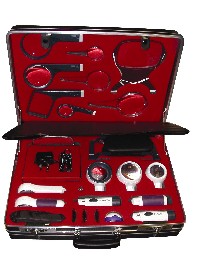Bill Harvey suggests that a useful range of low vision aids is easily obtained, and highlights a couple of developments making their use easier
The availability of magnifiers is widespread. As outlined in the CET article in this issue, many patients attend for a more specialised low vision assessment having already obtained magnifiers from other sources. Many of these are often inappropriate for the patient's needs, or often have been issued without any explanation to the patient about their proper use. An optometrist or optician is an obvious choice for giving the best advice about such aids, and access to a range of aids within can only help.
Illustrated here is an example of a typical simple low vision aid kit in its carrycase. The aids seen here are from Coil but products from other manufacturers, such as Eschenbach or Schweitzer, are also widely available.
 |
| Coil LVA kit. Image kindly supplied by Haag-Streit UK |
The illuminated stand magnifiers are particularly useful for more prolonged reading tasks. A problem with these has traditionally been difficulties with the batteries or mains adapter. The dependence on batteries is a particular problem with the infirm because the changing of batteries is often fiddly.
The gradual move over to LED light sources in illuminated LVAs has seen a significant improvement in battery life expectancy (as much as 10 times) and this has proved a boon for many visually impaired patients.
Also shown in the kit here is a flat-field magnifier, useful as a portable low power aid popular with children, and Halberg clips, allowing easy over-refraction of current spectacles.
